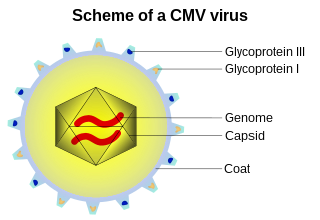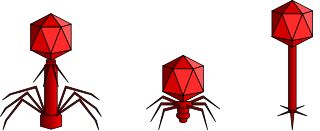P2virus is a genus of viruses in the order Caudovirales, in the family Myoviridae, in the subfamily Peduovirinae. Bacteria serve as natural hosts, with transmission achieved through passive diffusion. There are currently 13 species in this genus, including the type species Enterobacteria phage P2.
Schizot4virus is a genus of viruses in the order Caudovirales, in the family Myoviridae, in the subfamily Tevenvirinae. Bacteria serve as natural hosts. There are currently three species in this genus, including the type species Vibrio virus KVP40.
Felixounalikevirus is a genus of viruses in the order Caudovirales, in the family Myoviridae. Bacteria serve as natural hosts, with transmission achieved through passive diffusion.. There are currently three species in this genus, including the type species Salmonella phage FelixO1.
I3likevirus is a genus of viruses in the order Caudovirales, in the family Myoviridae. Bacteria serve as natural hosts, with transmission achieved through passive diffusion. There is currently only one species in this genus: the type species Mycobacterium phage I3.
Mulikevirus is a genus of viruses in the order Caudovirales, in the family Myoviridae. Bacteria serve as natural hosts, with transmission achieved through passive diffusion. There is currently only one species in this genus: the type species Enterobacteria phage Mu.
Pbunalikevirus is a genus of viruses in the order Caudovirales, in the family Myoviridae. Bacteria serve as natural hosts. There are currently seven species in this genus, including the type species Pseudomonas phage PB1.
Phikzlikevirus is a genus of viruses in the order Caudovirales, in the family Myoviridae. Bacteria serve as natural hosts. There are currently three species in this genus, including the type species Pseudomonas virus phiKZ.
Sp6likevirus is a genus of viruses in the family Podoviridae, within the subfamily Autographivirinae. Bacteria serve as the natural host, with transmission achieved through passive diffusion. There are currently five species in this genus, including the type species Enterobacteria phage SP6.
T7likevirus is a genus of viruses in the order Caudovirales, in the family Podoviridae, in the subfamily Autographivirinae. Bacteria serve as the natural host, with transmission achieved through passive diffusion. There are currently three species in this genus, including the type species Enterobacteria phage T7.
Phi29likevirus is a genus of viruses in the order Caudovirales, in the family Podoviridae, in the subfamily Picovirinae. Bacteria serve as natural hosts. There are currently four species in this genus, including the type species Bacillus phage phi29.
P22likevirus is a genus of virusesin the order Caudovirales, in the family Podoviridae. Bacteria serve as natural hosts, with transmission achieved through passive diffusion. There are currently four species in this genus, including the type species Enterobacteria phage P22.
C2likevirus is a genus of viruses in the family Siphoviridae, unassigned to a sub-family. Bacteria serve as the natural host, with transmission achieved through passive diffusion. There are currently two species in this genus, including the type species Lactococcus phage c2.
L5likevirus is a genus of viruses in the order Caudovirales, in the family Siphoviridae. Bacteria serve as natural hosts, with transmission achieved through passive diffusion.. There are currently 62 species in this genus, including the type species Mycobacterium phage L5.
Lambdavirus is a genus of viruses in the order Caudovirales, in the family Siphoviridae. Bacteria serve as natural hosts, with transmission achieved through passive diffusion.. There are currently three species in this genus, including the type species Enterobacteria phage lambda.
N15likevirus is a genus of viruses in the order Caudovirales, in the family Siphoviridae. Bacteria serve as natural hosts, with transmission achieved through passive diffusion. There is currently only one species in this genus: the type species Enterobacteria phage N15.
Phic3unalikevirus is a genus of viruses in the order Caudovirales, in the family Siphoviridae. Bacteria serve as natural hosts. There are currently three species in this genus including the type species Streptomyces phage phiC31.
Psimunalikevirus is a genus of viruses in the family Siphoviridae. Bacteria and archaea serve as the natural host, with transmission achieved through passive diffusion. There is currently one species in this genus: the type species Methanobacterium phage psiM1.
Spbetalikevirus is a genus of viruses in the order Caudovirales, in the family Siphoviridae. Bacteria serve as natural hosts. There is currently only one species in this genus: the type species Bacillus phage SPbeta.
T5likevirus is a genus of viruses in the order Caudovirales, in the family Siphoviridae. Bacteria serve as the natural host, with transmission achieved through passive diffusion. There are currently eight species in this genus, including the type species Enterobacteria phage T5.
Tunalikevirus is a genus of viruses in the order Caudovirales, in the family Siphoviridae. Bacteria serve as natural hosts. There are currently nine species in this genus, including the type species Enterobacteria phage T1.


